Advertisements
Advertisements
प्रश्न
Describe the structure and functioning of nephrons.
उत्तर
Nephrons are the basic filtering units of kidneys. Each kidney possesses a large number of nephrons, approximately 1-1.5 million. The main components of the nephron are the glomerulus, Bowman’s capsule, and a long renal tubule.
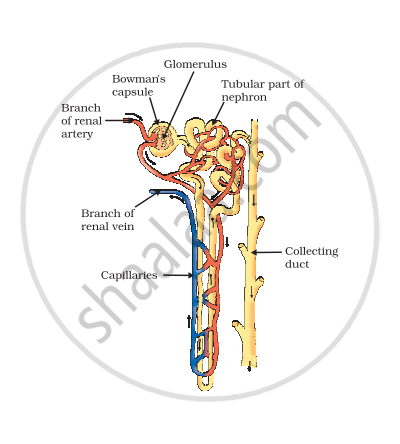
Functioning of a nephron:
- The blood enters the kidney through the renal artery, which branches into many capillaries associated with the glomerulus.
- The water and solute are transferred to the nephron at Bowman’s capsule.
- In the proximal tubule, some substances such as amino acids, glucose, and salts are selectively reabsorbed and unwanted molecules are added to the urine.
- The filtrate then moves down into the loop of Henle, where more water is absorbed.
- From here, the filtrate moves upwards into the distal tubule and finally to the collecting duct. The collecting duct collects urine from many nephrons.
- The urine formed in each kidney enters a long tube called the ureter. From the ureter, it gets transported to the urinary bladder and then into the urethra.
संबंधित प्रश्न
The kidneys in human beings are a part of the system for ______.
The given diagram represents a nephron and its blood supply. Study the diagram and answer the following questions:

(i) Label parts 1, 2, 3 and 4.
(ii) State the reason for the high hydrostatic pressure in the glomerulus.
(iii) Name the blood vessel which contains the least amount of urea in this diagram.
(iv) Name the two main stages of urine formation.
(v) Name the part of the nephron which lies in the renal medulla.
The diagram given below is that of a structure present in a human kidney.
Study the same and answer the questions that follow:
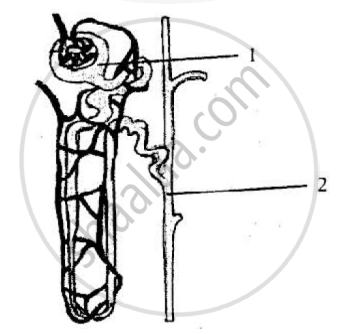
1) Name the structure represented in the diagram
2) What is the liquid entering part ‘1’ called?
Name two substances present in this liquid that are reabsorbed in the tubule.
3) What is the fluid that comes to part ‘2’ called?
Name the main nitrogenous waste in it.
4) Mention the three main steps involved in the formation of the fluid mentioned in (iii) above
5) Name the substance which may be present in the fluid in part ‘2’ if a person suffers from Diabetes mellitus.
Name the procedure used in the working of artificial kidney.
Why do some people need to use a dialysis machine? What does the machine do?
A dialysis machine contains long tubes coiled in a tank containing dialysing solution
What does the dialysing solution contain?
What are the methods used by plants to get rid of their waste products?
Where is urine carried through ureters?
What is urethra?
The excretory unit in the human excretory system is called:
The substance which is not reabsorbed into the blood capillaries surrounding the tuble of a nephron is mainly:
(a) glucose
(b) amino acid
(c) urea
(d) water
Answer the following in short.
List five waste products of plants.
Name the following:
The outer region of kidney containing the Bowman's capsule.
Name the following:
The tuft of capillaries inside the Bowman's capsule.
Name the following:
The part of kidney tubules where the term urine is first used for the fluid in it.
Given below is a set of five terms. Rewrite the terms in their correct order so as to be in logical sequence.
Renal artery, urethra, ureter, kidney, urinary bladder.
One of the following sets of body parts or substances or processed, pick out the one item which overall includes the remaining foir.
Skin, liver, lungs, kidneys, excretion.
Differentiate between the following pairs of terms:
Bowman’s capsule and malpighian capsule.
Given below is a simplified diagram of the human kidney cut open longitudinally. Answer the questions that follow.
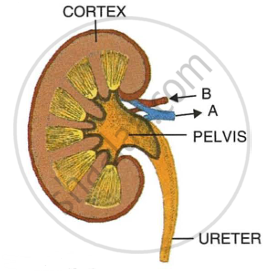 |
- Define excretion.
- Why does the cortex of the kidney show a dotted appearance?
- Why does the medulla of the kidney show a striped appearance?
- Write two differences in the composition of the blood flowing through the blood vessels 'A' and 'B'.
Study the diagram given alongside and then answer the question that follow:
Name the region in the kidney where the above structure is present?
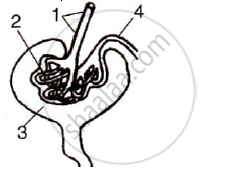
The following diagram represents a mammalian kidney tubule (nephron) and its blood supply.
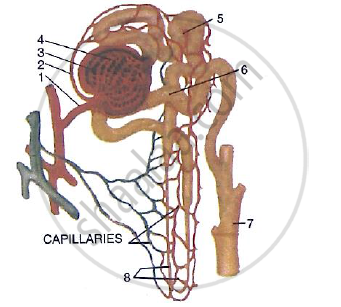
Parts indicated by the guidelines 1 to 8 are as follows:
1. Afferent arteriole from renal artery
2. efferent arteriole
3. Bowman’s capsule
4. Glomerulus;
5. Proximal convoluted tubule with blood capillaries;
6. Distal convoluted tubule with blood capillaries;
7. collecting tubule;
8. U-shaped loop of Henle
Study the diagram and answer the question that follow:
Where does ultrafiltration take place?
Explain in your own words with suitable examples.
How is excretion in plants useful to human beings?
Choose the correct answer:
Composition of extracellular fluid is regulated by ___________
Choose the correct answer:
Narrow apex of pyramid in kidney is called ___________
Name the following:
Functional unit of kidney.
Label the diagram given below :

Look at the figure given below. It is a section of human kidney as seen from the front.
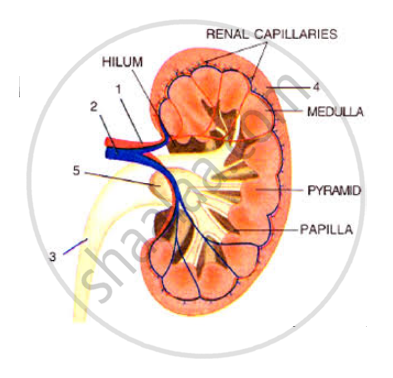
Which area/part (give its name and number given on the diagram) which contains the following:
(i) Malpighian capsule
(ii) The pyramids
(iii) Freshly collected urine
Given below is a highly simplified diagram of the human kidney cut open longitudinally. Answer the question that follow:
Why does the cortex of the kidney show a dotted appearance?
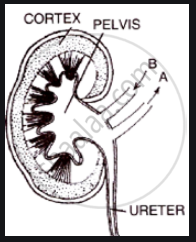
Draw a labeled diagram of the human kidney as seen in a longitudinal section.
Explain the Term: Glomerulus
Name the Following
The structural and functional units of kidney
Give Technical Term:
The organ which filters out urea and uric acid from the bloodstream.
Give Technical Term:
The organ in man concerned with maintaining water balance in the body.
State the Location: Medulla of Kidney
Write the functional activity of the following structure: Kidney
Write the functional activity of the following structure: Renal artery
Complete the diagram/chart with correct labels/ information. Write the conceptual details regarding it.
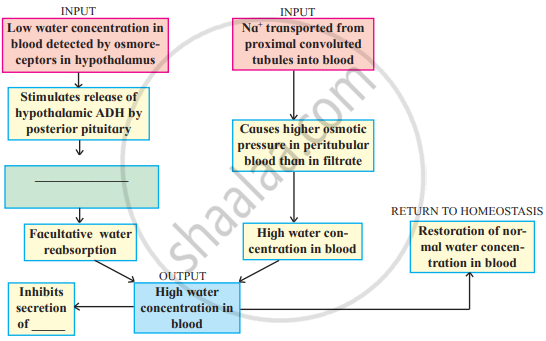
The habitat of animals that excrete nitrogenous waste in the form of urea.
Elimination of nitrogenous wastes in the form of uric acid takes place in ____________.
The main nitrogenous waste formed in the human body:
